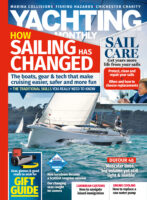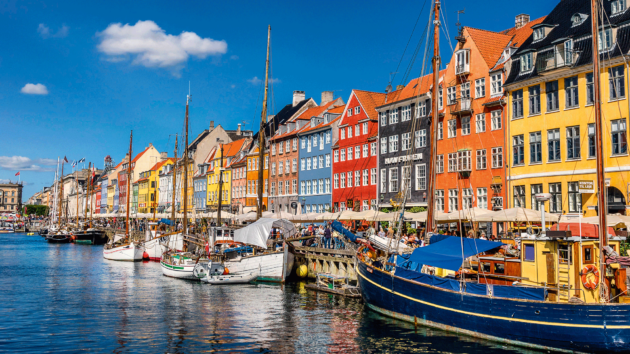No other European metropolis is as easily accessible by boat as Copenhagen. After cruising Copenhagen, tie up in the centre of the city that has so much to offer, as Detlef Jens explains
Sitting by the water on a hot summer’s day with a cool white wine in your hand? Even this can get better – with said cool white wine in hand, sitting on the pontoon and letting your legs dangle in the harbour. Or put your glass down and take a quick dip. Then order the next wine, or an espresso or maybe a really tasty lunch.
There were times when we seriously considered simply spending the entire day here, at La Banchina on the mega-trendy island of Refshaleøen after cruising Copenhagen. This is the only café at least that I know of with its own all-year bathing area, including a rustic wooden sauna, plus really good wines and Italian-inspired fresh cuisine.
And it is right on our short walk from where our boat is berthed in Margretheholm yacht harbour to the stop of the electric water bus, which then takes us right into the heart of Copenhagen’s bustling epicentre of life: Nyhavn.
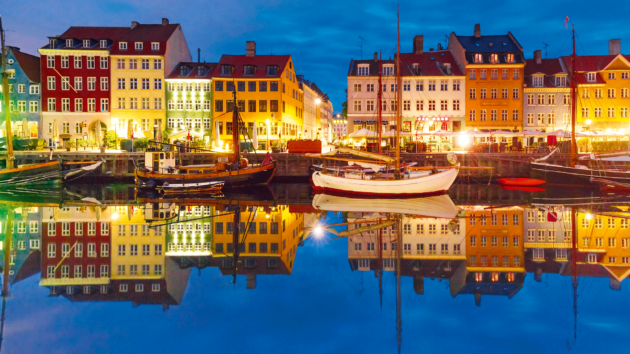
Nyhavn glows with colour at night. Photo: Alamy Stock Photo
Over the past decades, Copenhagen has advanced to become probably the trendiest, but also friendliest and most cosmopolitan of Europe’s capital cities. The place is so international that more English than Danish seems to be spoken here. Which obviously adds to the pleasure of simply being there and enjoying life. And that is exactly what one should do after having sailed the long way from the UK.
However, once through the Kiel Canal and from there out into the Baltic, it is only about 140 nautical miles to Copenhagen on the most direct route, which is south of Lolland and around Gedser and Møn. The more leisurely route on the other hand would be up into the Great Belt and then through the Smålandsfarvandet south of Sjælland, which also is the more scenic alternative. Even this, however, can be sailed in a few days.
Crusing Copenhagen: Shabby but charming
I could spend many happy weeks on Refshaleøen alone. The halls and industrial buildings of the former Burmeister & Wain shipyard, which has been closed for decades, is now home to various artists’ studios and creatively utilised office spaces that share the slightly shabby but very special charm of many former industrial sites.
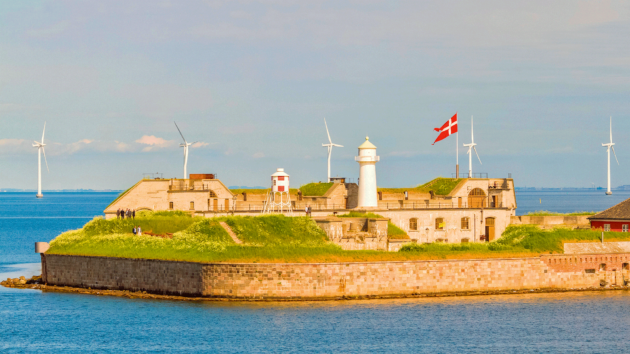
The Three Crowns Fortress at the entrance to Copenhagen harbour. Photo: Alamy Stock Photo
Together with cafés and bars, this draws a very happy and cheerful partying crowd especially in summer that also contributes to the magic of this special place. As of course does the presence of some of the finest restaurants in the world. The legendary noma has been chosen as the world’s best eating temple several times over and reservations must still be made weeks or even months in advance.
On the same street is Amass, founded by a former noma chef. It is surpassed by the completely crazy Alchemist a few metres further on, where dinner becomes a multi-hour event for all the senses.
For a completely different but also very enjoyable experience, visit the lively street food market Reffen, where you can get delicious and intercultural food or simply relax in one of the many deckchairs in the sun. Or immerse yourself in one of the many outdoor parties or concerts that always take place somewhere on Refshaleøen during summer.
Article continues below…
Sailing the Baltic Sea: where to go
Is the Baltic the new Mediterranean? Rachael Sprot takes a closer look at this underrated cruising ground
Zhik Spirit of Adventure: ‘We edged into Kyle Rhea as seals gazed away curiously’
Sea spray rose over the pushpit and the bow plunged into the restless black sea topped by frothing white streaks.…
Yacht-friendly capital
Opposite Refshaleøen is Copenhagen’s most traditional marina, Langelinie Yachthavn, virtually guarded by the Little Mermaid. Despite the swell from frequently passing tour boats, berths here are in popular demand so it takes a bit of luck to get one. No worries, though, as there are many other mooring options in Copenhagen.
No other European capital is as boat-friendly as this. The water in the city centre is clean enough to swim in, and many Copenhagen residents take full advantage of this on hot summer days. The city is well on the way to becoming climate-neutral and is truly cosmopolitan, full of bicycles, boats and remarkable, often pioneering architecture.
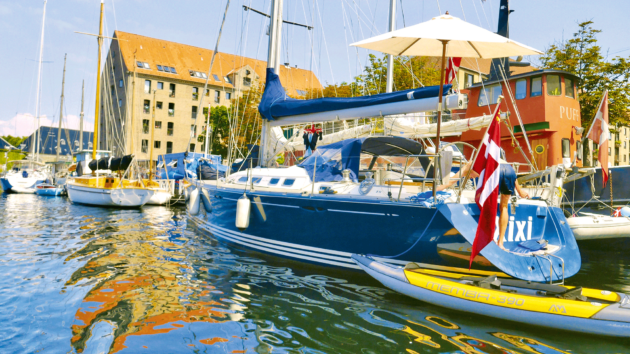
Tying up at Christianshavn Canal, home to all types of boat.
From our berth at the Lynetten Sailing Club in Margretheholm, for example, we have in view what is perhaps the most original waste recycling plant in the world, even with a year-round ski-slope on its steep roof: CopenHill. Other architectural beacons of the city are the spectacular opera house opposite Nyhavn and the Black Diamond a good distance further along on the other bank.
Like a diamond, the black façades reflect the light of the water and the sun, while the interior combines tradition and modernity. The impressive building is an extension of the old national library and also houses concert halls, the national photography museum, a café and a bookshop.
The Christianshavn Canal on the southern side of the main harbour is another good option for visiting yachts; a pedestrian bridge across its entrance opens frequently to let yachts pass through. Alternatively, you can head into Nyhavn which is rather lively, surrounded by pubs and restaurants and generally one of the city’s major tourist attractions.
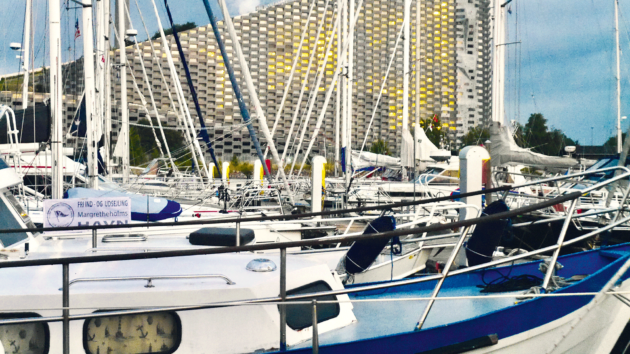
Lynetten Marina and CopenHill ski slope in the background. Photo: Alamy Stock Photo
Space alongside the pier is very limited and there are no shore facilities. Prepare to raft up and spend a boisterous night ashore!
Another central mooring space is alongside the pier in front of the Admiralen Hotel, used mainly by larger yachts, or alongside Kvæsthusbroen, which is the big pontoon directly opposite, for a grandstand view from your cockpit of what is happening in this part of the city. Small al fresco cafés beckon on the pontoon, and from time to time there are also large and small events here – open-air theatre, concerts or even public viewings of major football events.
Copenhagen is a water city and most of the action takes place along the harbour. This is of course very convenient for visitors who are travelling to the city on their own keel. Nevertheless, sometimes it is also worth discovering the ‘hinterland’. In this case, this is the famous shopping street Strøget, which starts at Kongens Nytorv just a few steps from the landward end of Nyhavn.

A map of Copenhagen. Image: Maxine Heath
Even more worthwhile is a visit to Torvehallerne, the city’s large market. Here you will find simply everything: fresh fruit and vegetables, fish, meat, cheese, wines, chocolates, spices and anything else you might need for cooking. This is the perfect place for shopping or just strolling and marvelling, but also for enjoying breakfast, lunch or even dinner. To get to the market, take a train or bus from Kongens Nytorv to Nørreport railway station.
Vibrant nightlife
If you’re confident enough to use land-based transport, you can also take your boat to one of the three larger marinas just north of the city – Svanemøllehavn, Kalkbrænderihavn or Tuborg Havn, where the prestigious KDY (Royal Danish Yacht Club) with its futuristic but cosy clubhouse is based.
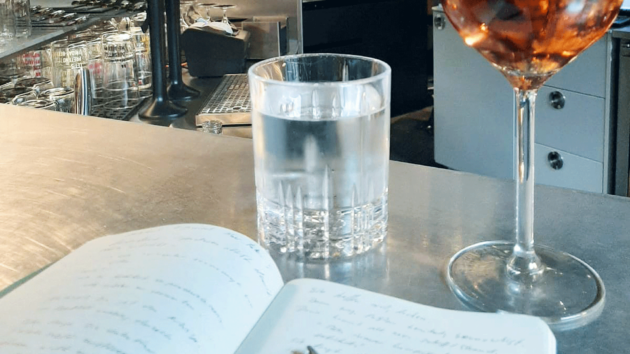
Detlef makes notes while enjoying a glass of wine.
From here, it’s also not far to the colourful student district of Nørrebro, somewhat off the beaten track and particularly interesting for its vibrant nightlife as well as some excellent bars and restaurants such as the French bistro Silberbauers or the truly Italian Casamadre.
For a pleasant sundowner or lunch break, steer for Den Vandrette wine bar on the water, just around the corner from Nyhavn. Even better is the sociable tradition at the wine bar Ved Stranden on Frederiksholm Canal. Each Monday from 1800, one of the friends of the house cooks something delicious, which is then served for 100 kroner per portion – while it lasts. This is characteristic of the relaxed and easy living atmosphere that makes Copenhagen such a magical place to visit.
What to do in Copenhagen
Chill out in Refshaleøen Street Food Market Reffen. An easy walk from Lynette Sail Club Marina in Margretheholm, or take the water bus from Nyhavn to Refshaleøen if moored elsewhere.
Visit the Torvehallen food market which is a feast for all the senses.
Visit the beautiful harbours along the Sound just north of Copenhagen, where many friendly sailing clubs welcome visitors.
Take the train (or your own boat) north for at least a full day in the world-famous art museum Louisiana; a vast collection of modern and contemporary art in a very scenic location on the Sound, next to the small harbour of Humlebæk.
Visit Den Blå Planet in southern Copenhagen, especially (but not only) with kids, to experience life in the world’s oceans. Tickets must be booked online: www.denblaaplanet.dk/en
Best places to tie up
Approaching Copenhagen from the south, beware of strong traffic in the Drogden channel between Kastrup airport and Saltholmen island. Stay out of the main channel and enter Copenhagen harbour through Lynetten Løbet channel. Coming from the north, note that the direct approach through Kronløb is closed for yachts, use Lynetten Løb further south instead.
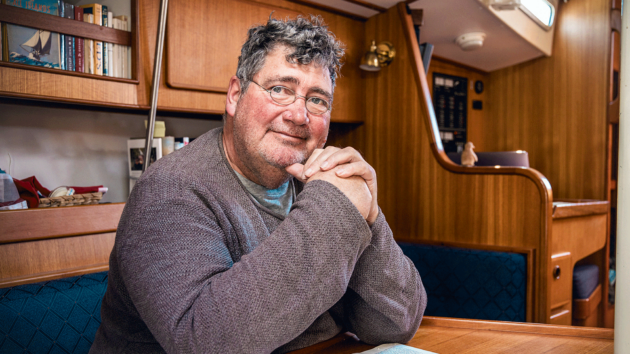
Detlef Jens writes for magazines in Germany, the UK and USA, and has written several sailing books in English and German, including three novels.
Magretheholms Havn Lynetten Friendly sailing club marina on Refshaleøen.
Wilders Plads Marina/Christianshavn Canal
Very centrally located but also very expensive.
Svanemøllehavn Large sailing club marina in northern Copenhagen.
Public transport into the city.
www.smhavn.dk
Kalkbrænderihavnen
New marina close to the city, convenient public transport (Orient underground station).
www.sejlklubbenkbh.dk/kalkbraenderihavnen
Tuborg Havn/KDY Harbour of the KDY, the Royal Danish Yacht Club.
Welcome to visitors, nice clubhouse, public transport into the city.
www.marinaguide.dk/en/tuborg-harbour
Langelinie Havn Very scenic, by the Little Mermaid, about 2km walk into town.
Enjoyed reading this?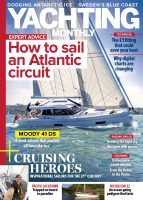
A subscription to Yachting Monthly magazine costs around 40% less than the cover price, so you can save money compared to buying single issues.
Print and digital editions are available through Magazines Direct – where you can also find the latest deals.
YM is packed with information to help you get the most from your time on the water.
-
-
- Take your seamanship to the next level with tips, advice and skills from our experts
- Impartial in-depth reviews of the latest yachts and equipment
- Cruising guides to help you reach those dream destinations
-
Follow us on Facebook, Twitter and Instagram.
Note: We may earn a commission when you buy through links on our site, at no extra cost to you. This doesn’t affect our editorial independence.

